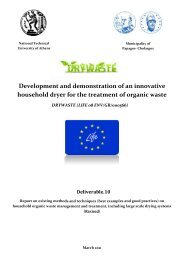MOROCOMP (LIFE TCY05/MA000141) - Unit of Environmental ...
MOROCOMP (LIFE TCY05/MA000141) - Unit of Environmental ...
MOROCOMP (LIFE TCY05/MA000141) - Unit of Environmental ...
Create successful ePaper yourself
Turn your PDF publications into a flip-book with our unique Google optimized e-Paper software.
carbon for each part <strong>of</strong> nitrogen by weight, although ratios from 20:1 up to 40:1 can<br />
give good composting results [24, 25, 37, 38]. Low ratios supply the mixture with<br />
excess <strong>of</strong> nitrogen which is lost as ammonia gas 6 creating undesirable odors whereas<br />
high C:N ratios cause shortage <strong>of</strong> nitrogen and the degradation rate <strong>of</strong> the composting<br />
material remains relatively low since micro-organisms must go through many lifecycles,<br />
oxidizing <strong>of</strong>f the excess carbon until a more convenient C:N ratio for their<br />
metabolism is reached. In addition nitrogen limitation may lead to extensive organic<br />
acid formation from carbonaceous waste, which tends to lower the pH and thereby<br />
retard the microbial activity. The ratio is weighted in favor <strong>of</strong> carbon, because uses for<br />
carbon outnumber those for nitrogen in microbial metabolism and synthesis <strong>of</strong><br />
cellular materials. Not only is carbon utilized in cell wall or membrane formation,<br />
protoplasm, and storage products synthesis but also an appreciable amount is also<br />
oxidized to CO 2 in metabolic activities. On the other hand, nitrogen has only one<br />
major use as a nutrient namely as an essential constituent <strong>of</strong> protoplasm.<br />
Consequently, much more carbon than nitrogen is required. Figure 10 presents the<br />
carbon nitrogen ratio evolution during the 1 st composting trial.<br />
[C/N]<br />
18<br />
16<br />
14<br />
12<br />
10<br />
8<br />
1 3 5 7 9 11 13 15 17 19 21 23 25 27 29<br />
Days<br />
Figure 10: Changes in C:N ratio during the 1 st composting trial<br />
According to Figure 10 during the 1 st composting trial, the C:N ratio presents a<br />
steadily downwards inclination. This inclination can be explained by the carbon loss<br />
6 leads to excess ammonia formation, which increases the pH and thereby enhances ammonia<br />
volatilization<br />
46










